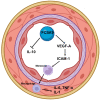Non-Lipid Effects of PCSK9 Monoclonal Antibodies on Vessel Wall
- PMID: 35806908
- PMCID: PMC9267174
- DOI: 10.3390/jcm11133625
Non-Lipid Effects of PCSK9 Monoclonal Antibodies on Vessel Wall
Abstract
Elevated low density lipoprotein (LDL) cholesterol and lipoprotein(a) (Lp(a)) levels have an important role in the development and progression of atherosclerosis, followed by cardiovascular events. Besides statins and other lipid-modifying drugs, PCSK9 monoclonal antibodies are known to reduce hyperlipidemia. PCSK9 monoclonal antibodies decrease LDL cholesterol levels through inducing the upregulation of the LDL receptors and moderately decrease Lp(a) levels. In addition, PCSK9 monoclonal antibodies have shown non-lipid effects. PCSK9 monoclonal antibodies reduce platelet aggregation and activation, and increase platelet responsiveness to acetylsalicylic acid. Evolocumab as well as alirocumab decrease an incidence of venous thromboembolism, which is associated with the decrease of Lp(a) values. Besides interweaving in haemostasis, PCSK9 monoclonal antibodies play an important role in reducing the inflammation and improving the endothelial function. The aim of this review is to present the mechanisms of PCSK9 monoclonal antibodies on the aforementioned risk factors.
Keywords: PCSK9 monoclonal antibodies; coagulation; endothelial dysfunction; fibrinolysis; haemostasis; inflammation; thrombosis.
Conflict of interest statement
The authors declare that they have no conflict of interest.
Figures



Similar articles
-
Efficacy and Safety of PCSK9 Monoclonal Antibodies in Patients at High Cardiovascular Risk: An Updated Systematic Review and Meta-Analysis of 32 Randomized Controlled Trials.Adv Ther. 2020 Apr;37(4):1496-1521. doi: 10.1007/s12325-020-01259-4. Epub 2020 Feb 27. Adv Ther. 2020. PMID: 32108309
-
Proprotein convertase subtilisin/kexin type 9 (PCSK9) inhibitors: Present perspectives and future horizons.Nutr Metab Cardiovasc Dis. 2016 Oct;26(10):853-62. doi: 10.1016/j.numecd.2016.05.006. Epub 2016 May 30. Nutr Metab Cardiovasc Dis. 2016. PMID: 27352986 Review.
-
PCSK9 Biology and Its Role in Atherothrombosis.Int J Mol Sci. 2021 May 30;22(11):5880. doi: 10.3390/ijms22115880. Int J Mol Sci. 2021. PMID: 34070931 Free PMC article. Review.
-
Targeting PCSK9 as a promising new mechanism for lowering low-density lipoprotein cholesterol.Pharmacol Ther. 2016 Aug;164:183-94. doi: 10.1016/j.pharmthera.2016.04.011. Epub 2016 Apr 29. Pharmacol Ther. 2016. PMID: 27133571 Review.
-
Is there enough evidence with evolocumab and alirocumab (antibodies to proprotein convertase substilisin-kexin type, PCSK9) on cardiovascular outcomes to use them widely? Evaluation of Sabatine MS, Giugliano RP, Wiviott SD et al. Efficacy and safety of evolocumab in reducing lipids and cardiovascular events. N Engl J Med 2015;372:1500-1509, and Robinson JG, Farnier M, Krempf M et al. Efficacy and safety of alirocumab in reducing lipids and cardiovascular events. N Engl J Med 2015;372:1488-99.Expert Opin Biol Ther. 2015;15(12):1671-5. doi: 10.1517/14712598.2015.1093109. Epub 2015 Sep 28. Expert Opin Biol Ther. 2015. PMID: 26414456
Cited by
-
PCSK9 inhibitors ameliorate arterial stiffness in ACS patients: evidences from Mendelian randomization, a retrospective study and basic experiments.Front Med (Lausanne). 2024 May 27;11:1408760. doi: 10.3389/fmed.2024.1408760. eCollection 2024. Front Med (Lausanne). 2024. PMID: 38860206 Free PMC article.
-
The Anti-Thrombotic Effects of PCSK9 Inhibitors.Pharmaceuticals (Basel). 2023 Aug 22;16(9):1197. doi: 10.3390/ph16091197. Pharmaceuticals (Basel). 2023. PMID: 37765005 Free PMC article. Review.
-
The Pleiotropic Effects of Lipid-Modifying Interventions: Exploring Traditional and Emerging Hypolipidemic Therapies.Metabolites. 2024 Jul 17;14(7):388. doi: 10.3390/metabo14070388. Metabolites. 2024. PMID: 39057711 Free PMC article. Review.
-
Comment on “Risk of Venous Thromboembolism with Statins: Evidence Gathered via a Network Meta-analysis”.Balkan Med J. 2024 Jan 3;41(1):83-84. doi: 10.4274/balkanmedj.galenos.2023.2023-10-17. Epub 2023 Nov 17. Balkan Med J. 2024. PMID: 37973918 Free PMC article. No abstract available.
-
PCSK9 inhibitors for acute coronary syndrome: the era of early implementation.Front Cardiovasc Med. 2023 May 2;10:1138787. doi: 10.3389/fcvm.2023.1138787. eCollection 2023. Front Cardiovasc Med. 2023. PMID: 37200976 Free PMC article. Review.
References
-
- Benjamin E.J., Muntner P., Alonso A., Bittencourt M.S., Callaaway C.W., Carson A.P., Chamberlain A.M., Chang A.R., Cheng S., Das S.R., et al. Heart disease and stroke statistics—2019 update: A report from the American Heart Association. Circulation. 2019;139:e1–e473. doi: 10.1161/CIR.0000000000000659. - DOI - PubMed
-
- Borén J., Chapman M.J., Krauss R.M., Packard C.J., Bentzon J.F., Binder C.J., Daemen M.J., Demer L.L., Hegele R.A., Nicholls S.J., et al. Low-density lipoproteins cause atherosclerotic cardiovascular disease: Pathophysiological, genetic, and therapeutic insights: A consensus statement from the European Atherosclerosis Society Consensus Panel. Eur. Heart J. 2020;41:2313–2330. doi: 10.1093/eurheartj/ehz962. - DOI - PMC - PubMed
-
- Krychtiuk K.A., Lenz M., Hohensinner P., Distelmaier K., Schrutka L., Kastl S.P., Huber K., Dostal E., Oravec S., Hengstenberg C., et al. Circulating levels of proprotein convertase subtilisin/kexin type 9 (PCSK9) are associated with monocyte subsets in patients with stable coronary artery disease. J. Clin. Lipidol. 2021;15:512–521. doi: 10.1016/j.jacl.2021.02.005. - DOI - PubMed
Publication types
Grants and funding
LinkOut - more resources
Full Text Sources
Miscellaneous

